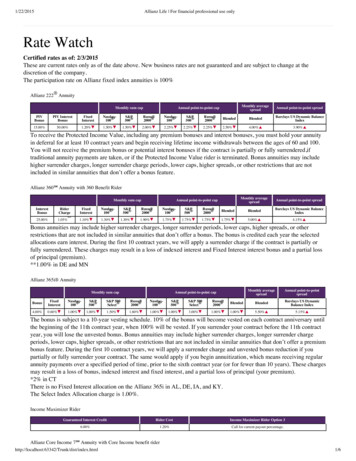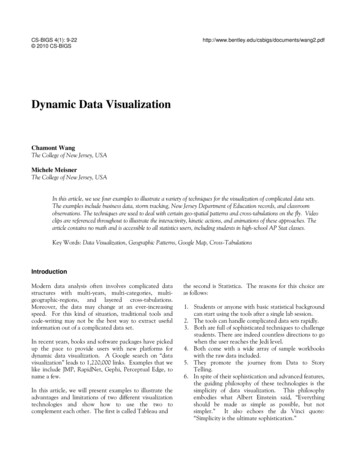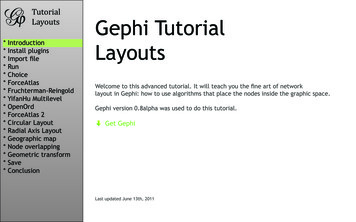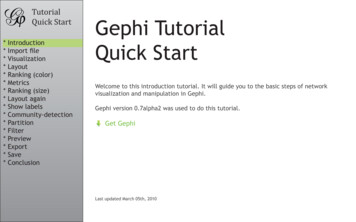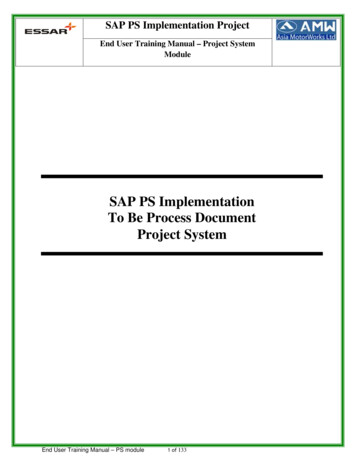
Transcription
Simple Gephi Project from A to ZTable of ContentsDescription of the project . . . . . . . . . . . . . . . . . . . . . . . . . . . . . . . . . . . . . . . . . . . . . . . . . . . . . . . . . . . . . . . . . . . . 1be familiar with the terminology to discuss networks . . . . . . . . . . . . . . . . . . . . . . . . . . . . . . . . . . . . . . . . . . 2download a network file . . . . . . . . . . . . . . . . . . . . . . . . . . . . . . . . . . . . . . . . . . . . . . . . . . . . . . . . . . . . . . . . . . . . . 3description of the file / the network. . . . . . . . . . . . . . . . . . . . . . . . . . . . . . . . . . . . . . . . . . . . . . . . . . . . . . . . . . . 3open the network in Gephi. . . . . . . . . . . . . . . . . . . . . . . . . . . . . . . . . . . . . . . . . . . . . . . . . . . . . . . . . . . . . . . . . . . 3read the report after opening a file . . . . . . . . . . . . . . . . . . . . . . . . . . . . . . . . . . . . . . . . . . . . . . . . . . . . . . . . . . . 4initial view . . . . . . . . . . . . . . . . . . . . . . . . . . . . . . . . . . . . . . . . . . . . . . . . . . . . . . . . . . . . . . . . . . . . . . . . . . . . . . . . . 4basic view of Gephi’s interface . . . . . . . . . . . . . . . . . . . . . . . . . . . . . . . . . . . . . . . . . . . . . . . . . . . . . . . . . . . . . . . 5showing labels of the nodes . . . . . . . . . . . . . . . . . . . . . . . . . . . . . . . . . . . . . . . . . . . . . . . . . . . . . . . . . . . . . . . . . . 7layout ("spatialize") the network . . . . . . . . . . . . . . . . . . . . . . . . . . . . . . . . . . . . . . . . . . . . . . . . . . . . . . . . . . . . . 8visualize the properties of the nodes. . . . . . . . . . . . . . . . . . . . . . . . . . . . . . . . . . . . . . . . . . . . . . . . . . . . . . . . . . 9prettify the network for enhanced readability . . . . . . . . . . . . . . . . . . . . . . . . . . . . . . . . . . . . . . . . . . . . . . . . 12computing the centrality of the nodes. . . . . . . . . . . . . . . . . . . . . . . . . . . . . . . . . . . . . . . . . . . . . . . . . . . . . . . . 14visualize attributes created by Gephi . . . . . . . . . . . . . . . . . . . . . . . . . . . . . . . . . . . . . . . . . . . . . . . . . . . . . . . . 16exporting a network as a picture . . . . . . . . . . . . . . . . . . . . . . . . . . . . . . . . . . . . . . . . . . . . . . . . . . . . . . . . . . . . 20export a network as a web visualization . . . . . . . . . . . . . . . . . . . . . . . . . . . . . . . . . . . . . . . . . . . . . . . . . . . . . 23the end . . . . . . . . . . . . . . . . . . . . . . . . . . . . . . . . . . . . . . . . . . . . . . . . . . . . . . . . . . . . . . . . . . . . . . . . . . . . . . . . . . . 26questions and exercises . . . . . . . . . . . . . . . . . . . . . . . . . . . . . . . . . . . . . . . . . . . . . . . . . . . . . . . . . . . . . . . . . . . . 26last modified: 2021-09-25Description of the projectThis project is for complete beginners to Gephi. It supposes you have Gephi installed and runningon your computer. That is all.When finishing this tutorial, you should be able to: be familiar with the vocabulary to discuss networks1
download a network file for this exercise description of the file / the network open a network file read the report after opening a file show the labels of the nodes layout the network visualize attributes of the network prettify the network for enhanced readability compute the centrality of the nodes in the network visualize attributes created by Gephi export a visualization as a picture or pdf export a web visualization of the networkbe familiar with the terminology to discussnetworksFigure 1. terminology for networks2
download a network filedownload this zip file and unzip it on your computer.You should find the file miserables.gexf in it.Save it in a folder you will remember (or create a folder specially for this small project).description of the file / the networkThis file contains a network representing "who appears next to whom" in the 19th century novel[1]Les Misérables by Victor Hugo .A link between characters A and B means they appeared on the same page or paragraph in thenovel.The file name ends with ".gexf", which just means this is a text file where the network informationis stored (name of the characters, their relations, etc.), following some conventions.open the network in Gephi open Gephi. On the Welcome screen that appears, click on Open Graph File find miserables.gexf on your computer and open itFigure 2. welcome screen3
read the report after opening a fileA report window will open, giving you basic info on the network you opened:Figure 3. report windowThis tells you that the network comprises 74 characters, connected by 248 links.Links are undirected, meaning that if A is connected to B, then it is the same as B connected to A.The report also tells us the graph is not dynamic: it means there is no evolution or chronology, itwon’t "move in time".Click on OK to see the graph in Gephi.initial view4
Figure 4. initial view when opening a graphThis is how the network appears in Gephi. Not very useful! Let’s examine what we have here.basic view of Gephi’s interfaceFigure 5. the 3 main screens in GephiGephi has 3 main screens:1. Overview: where we can explore the graph visually2. Data Laboratory: provides an "Excel" table view of the data in network5
3. Preview: where we polish the visualization before exporting it as a pictue or pdfWhat we see here is the Overview.Figure 6. Filters and statistics panels in GephiIn the Overview, the graph is shown at the center. Around it, several panels help us fine tune thevisualization.4. "Filters", where we can hide different parts of the network under a variety of conditions5. "Statistics", where we can compute metrics on the networkFigure 7. Appearance and layout panels in Gephi6
6. "Appearance", where we can change colors and sizes in interesting ways7. "Layouts", where we can apply automated procedures to change the position of the networkFigure 8. 3 groups of icons8. A series of icons to add / colorize nodes and links manually, by clicking on them9. Options and sliders to change the size of all nodes, links, or labels10. More options become visible if we click on this little arrow head pointing upshowing labels of the nodesFigure 9. showing node labels7
layout ("spatialize") the networkFigure 10. selecting the force atlas 2 layoutFigure 11. changing a few parameters and launching the layout8
Figure 12. result of Force Atlas 2 layoutvisualize the properties of the nodesA network consists in entities and their relations. This is what we just visualized. Yet, the propertiesof these entities remain invisible.For instance: the characters in the novel "Les Misérables" are male or female. Are males more likelyto be connected to males, or females? Just looking at the network in Gephi, we can’t tell.Now, we will see how to make this property ("Gender") visible.9
Figure 13. Switching the view to the data laboratoryFigure 14. We see there is a Gender attribute for each character.We will color the nodes based on their gender. To do that, we select Gender in the Appearance panel:10
Figure 15. Coloring nodes according to their genderThe result:11
Figure 16. After coloring characters according to their genderprettify the network for enhancedreadabilityThere are a number of issues with the result we get:1. the network is too big or too small, it is hard to read2. the labels of the characters overlap3. the size of the labels might be too big / small4. the links are sometimes too largeLet’s fix these issues.12
1. Enlarge or shrink the network either we use the "scaling" parameter of the layout, as we have seen here. or the scale is fine, it is just that we need to zoom it or out. Use the scrolling wheel of yourmouse, and right click to move the network.2. Prevent the Labels from overlappingIn the layout panel, choose "Label Adjust" or "Noverlap": these layouts will move the nodes just sothat the Labels stop overlapping:Figure 17. Noverlap or Label Adjust will help youDon’t forget to click on "Run" to apply these layouts.3. Changing the size of the labelsOpen the bottom panel of Gephi by clicking on tiny arrow head (1). Then select "nodes" (2), thenmove the slider (3).Figure 18. Adjusting label size13
4. Adjusting the thickness of the linksFigure 19. Adjusting edge thicknesscomputing the centrality of the nodes1. Definitions of centrality"Centrality" is a very good metrics to first get an idea of a network. What does centrality mean?Intuitively, we understand that a "central" node will probably sit in the middle of the network. Buthow to measure that "scientifically", so that we have an objective confirmation of our visualimpression?There are several ways, all equally interesting.We can measure degree centrality. "Degree" is the technical term for "number of connections thata node has".So, degree centrality just means that the most central node is the node which has the mostconnections. Simple!Another measure is betweenness centrality. This one is more tricky. First, you have to imagine what is a shortest path. A path from node A to node B is a chain of nodes, the road if you will, that you have to traverseto go from A to B. The shortest path from A to B is the quickest road from A to B: the path that has the smallestnumber of nodes between A and B. A node which is on many shortest paths is "between" many nodes. And when you realize it, it is14
a very intuitive sense of what it means to "be central". These nodes have a high betweennesscentrality.2. Computing betweenness centrality with GephiGephi computes it for you. Find "Network diameter" in the statistics panel and click "run":Figure 20. Computing betweenness centralityThis will open a window with parameters (explained in a more advanced tutorials). Click "OK":Figure 21. Parameters for the computation of betweenness centralityA report window opens (also explained in a other tutorials). Close it.15
Figure 22. Report after the computation of betweenness centralityNow we can visualize this information.visualize attributes created by GephiGephi has computed for us the betweenness centrality of all nodes. This remains invisible on thenetwork, however.It would be interesting to, say, resize the nodes according to their centrality: the more central anode, the bigger. This would allow for a very quick visual appreciation of which nodes are the mostcentral.First, let’s switch to the data laboratory to see how Gephi stored the "betweenness centrality" ofeach node:Figure 23. Switching the view to the data laboratory16
When we ran "Network Diameter" in the statistics panel, Gephi has actually computed many kindsof centralities (not just "betweenness centrality"):Figure 24. Different centrality measures visible in the data laboratoryTo resize the nodes according to the value of their betweenness centrality, we use the Appearancepanel: make sure you select the correct optionsFigure 25. Ranking node sizes by centrality17
Figure 26. Selecting the minimum and maximum sizes of nodesFigure 27. Result of the ranking18
Figure 28. Resizing labels to reflect their node’s sizeFigure 29. Result of the label resizing19
exporting a network as a picture1. exporting a screenshot from the Overview (a png image)Figure 30. Open the configuration panel for screenshotsSelect the maximum value for anti-aliasing, and multiply values for width and height for higherresolution. For example, resolution x 3 is width 3072 and height 2304Figure 31. The configuration panel for screenshots2. exporting a pdf or svg pictureLet’s switch to the preview panel:20
Figure 32. Switching to the preview panelThe preview panel is dedicated to the preparation of the picture to be exported as a pdf or svg,which are "scalable": in pdf or sv, the resolution of the graph will remain perfect, even with astrong zoom. But as you see, it means the network is now looking different than in the Overview. contrary to the Overview panel, here you need to hit the "refresh" button aftereach parameter change.Figure 33. Updating the parametersHere I change just 2 parameters: Show Labels and Font (which I reduce to size "5"), to get:21
Figure 34. Result of previewExport: just click on the button and select the file format you preferFigure 35. Export button3. download the result filedownload this zip file if you need to see the network in its final form.22
export a network as a web visualizationYou can easily create a web-based version of your network. It can be made public or private. If youchoose to make it public, it will be easy to share - simply send the url.The web version makes use of VOSviewer online, which works best for networks up to 500 nodes(if your networks has more nodes, it can be hard to read on screen).To proceed, simply:1. export your graph from Gephi as a .gexf file make sure you export a gexf file, not a GEPHI file!In Gephi, do: File Export Graph file See an illustration below:Figure 36. Export gexf file 123
Figure 37. Export gexf file 22. visit nocodefunctions and convert the gexf file to a web visualizationNocode functions is a web application that I developed. It provides useful tools to work withnetworks and text. It is free, does not need a registration, and is respectful of your data. Go to this page on nocodefunction. Choose option 1 ("convert a Gephi gexf file to VOSviewer json format") If you want to share your visualization, check the box to make it public Click on "Convert to VOSviewer json file"You will be directed to a new webpage like the one below:Figure 38. An illustration of the web view of a gexf file24
3. public or private web visualization? How to manageIf you have chosen "public" at the previous step you can now bookmark the web page of yournetwork, share it, etc. Otherwise, the visualization will be deleted after an hour. This is to keepthe promise that your data is secure: if you want it private, we simply don’t keep it on the servers.What if you want to keep your visualization private, but don’t want to redo all the steps after eachhour? in the VOSviewer visualization, save your network as a json file by clicking on the "save" icon:Figure 39. Saving the network to a json file from the VOSviewer online interfaceThen, you can re-open this file in the web interface whenever you want: Visit this page by nocode functions or the official page by VOSviewer online, and open yournetwork in it:25
Figure 40. Opening a network in the VOSviewer online interface4. More options to share your visualization with VOSviewer onlineThis web page offers a full view on the other ways you can share a network visualization withVOSviewer online.the endVisit the Gephi group on Facebook to get help,or visit the website for more tutorialsquestions and exercises1. Open the file miserables.gexf with a text editor (here is how to do it on a Mac, and on Windows).See how the nodes and the links are written in the file. Can you find the character Javert?2. Our network of Les Miserables characters was undirected. Can you think of networks which aredirected?Imagine how undirected and directed networks differ when computing centrality, for example.3. Force Atlas 2 is a layout which brings together connected nodes, and spreads out unconnectednodes. We might have nodes with no relation at all with other nodes (called "isolated nodes").How will these isolated nodes move on screen?4. When applying the Force Atlas 2 layout, the network moves quickly, then stabilizes, and thenkeeps moving a bit.Can you guess why this is happening?5. In the list of layouts, Force Atlas 2 is just one of many options you can choose. Try "Fruchterman26
Reingold" and "Yfan Hu".These are layouts which follow the same logic as Force Atlas 2, but with slight variations. Explorehow these algorithms result in similar, yet specific layouts.6. In this tutorial, we defined degree centrality. Can you imagine a situation when a node with thelargest degree centrality will actually be in the periphery of the network? You can draw a toynetwork to help you figure.[1] D. E. Knuth, The Stanford GraphBase: A Platform for Combinatorial Computing, Addison-Wesley, Reading, MA (1993)27
download a network file download this zip file and unzip it on your computer. You should find the file miserables.gexf in it. Save it in a folder you will remember (or create a folder specially for this small project).


